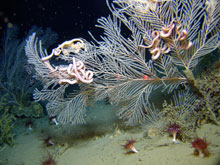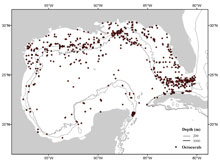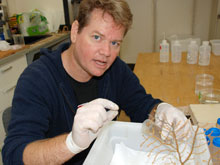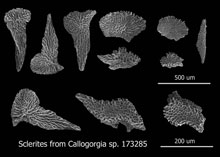
Callogorgia sp. octocorals from 300 meters (984 feet) in the Green Canyon region in the Gulf of Mexico. Brittle stars are on the coral colony and Javania sp. cup corals are around the base. Click image for larger view and image credit.
Diversity of Octocorals
August 28, 2009
Peter J. Etnoyer
Marine Biologist
Harte Research Institute
Texas A&M University – Corpus Christi
![]() This Iridogorgia octocoral from DeSoto Canyon was videoed during Jason Dive 454.
This Iridogorgia octocoral from DeSoto Canyon was videoed during Jason Dive 454.
Most people know octocorals as the large colorful sea fans that decorate the pages of exotic travel magazines. Actually, octocorals come in a wide variety of shapes and sizes, and they occur at great depths. What all octocorals have in common is eight pinnate tentacles on each polyp, compared to hard corals, which have multiples of six. Octocorals go by many names, including gorgonians, soft corals, sea pens, and sea feathers. Each of these names reflects a different group of octocorals adapted to a different suite of environmental conditions, and each group contributes to the overall diversity of octocorals in the Gulf of Mexico.
Octocorals grow well beyond the range of the Lophelia pertusa colonies — 300 to 800 meters (984 to 2,625 feet) — that serve as the flagship species for this expedition. They provide structure, and habitat, where few other corals grow. Octocorals are broadly distributed throughout the Gulf of Mexico down to 4,800 m (15,748 ft). The map below illustrates their remarkable vertical range throughout the Gulf.
The Gulf of Mexico is, in fact, one the best-studied regions in the world for this poorly known group of colonial animals. Taxonomists (a scientist who classifies organisms) have taken interest in the octocorals of the Gulf since the late-nineteenth century, when the dredges of the Challenger Expedition hauled them the octocorals aboard under the direction of scientific director Sir Wyville Thomson. A series of researchers followed on since then, including Dr. Elizabeth Deichmann (1930s), Dr. Frederick M. Bayer (1950s and beyond), and most recently, Dr. Stephen D. Cairns (1970s and on) from the Smithsonian Institution National Museum of Natural History. Their combined efforts — as well as the work of others — have documented nearly 300 species of octocorals in the Western Atlantic, half of which are known to occur in the Gulf of Mexico.

A map of locations where octocorals have been collected in the Gulf of Mexico since the nineteenth century. Click image for larger view and image credit.
You might think that after 100 years of research we could stop exploring for octocorals, but that’s really not the case. Much remains to explore. For example, since the Ocean Explorer Lophelia II project got underway last year, we have documented three octocoral species never before known to occur in the Gulf, including two species of bubblegum corals (Paragorgia sp. and Sibogagorgia sp.). We wouldn’t know these discoveries were new if it weren’t for the diligence of scientists that went before.
We have one large advantage aboard this cruise that early octocoral researchers did not: namely, a finely tuned and highly capable remotely operated vehicle (ROV) named Jason II. Early researchers hauled broken colonies up from the depths in dredges that leveled the seafloor, but now we are able to observe the colonies alive, in their natural habitat, surrounded by fishes, brittle stars, and other associated species. Even when we find well-known octocorals, like Callogorgia sp., we see them in a new light, as part of a diverse community of animals co-existing in a cold, dark ocean environment. So, ocean exploration is ongoing. These new discoveries continue to shed light on the important role of octocorals in deep-sea ecosystems.
Our next steps will be to understand how octocorals in one region differ from another, and to learn how these populations are connected. We do this so we can protect "vital links" in the network, and guard hotspots of deep-coral biodiversity around the world, in an effort to ensure their viability for future generations.





























